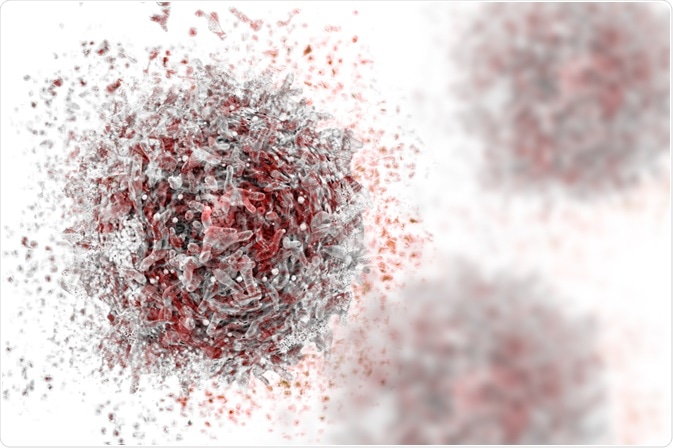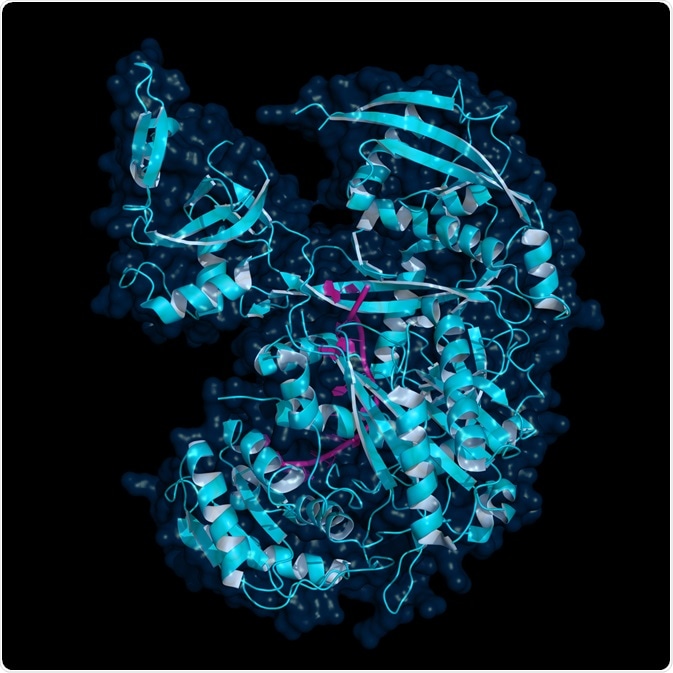The main idea behind miRNA silencing therapies for cancer and other disease treatment is based upon the concept that such diseases often result from the expression of undesired and/or mutated genes, or due to the overexpression of normal genes.
Therefore, miRNA silencing therapies can prevent targeted miRNAs from functioning properly to ultimately reduce cancer progression.

Image Credit: CI Photos/Shutterstock.com
What is microRNA?
MicroRNA (miRNA) molecules are non-coding RNAs that most commonly emerge following the transcription of their DNA sequences into primary miRNAs. Primary miRNAs are then processed into precursor miRNAs until they are exported to the cytoplasm, where they are processed into mature miRNAs. At a total length of 18–22 nucleotides, miRNAs play an important role in various aspects of gene expression.
Very often, miRNAs will interact with the 3’ UTR (untranslated region) of target mRNAs to suppress gene expression through either perfect or imperfect complementary binding. Much of this gene suppression is attributed to the ability of miRNAs to block translation or induce degradation of their target mRNAs.
Other interactions of miRNAs during gene expression have been reported to involve the 5’ UTR of mRNAs, coding sequences, and gene promoters. Computational predictions have found that each miRNA molecule is capable of binding to hundreds of different mRNA targets, which, taken together, estimate that miRNAs play a role in the regulation of more than half of the protein-coding genes in humans.
Studying miRNAs
Through the use of databases containing information on dysregulated miRNAs, as well as several laboratory techniques (RNA-sequencing, real time-qualitative polymerase chain reaction (RT-qPCR), western blot analysis or array expression profiling of in-house cohorts), scientists have been able to identify and study the biological functions of miRNAs to determine their role in cancers.
These studies have demonstrated that the loss or overexpression of even a single miRNA molecule can dramatically alter normal cellular homeostasis.
The role of miRNAs in disease
Due to the various critical functions associated with miRNAs, alterations in the expression of these genetic molecules can lead to several human diseases, including liver inflammation and fibrosis, cardiovascular diseases, and several different types of cancer.
As compared to its contribution to other diseases, miRNA dysregulation has demonstrated a predominant role in the pathogenesis of cancer.
Gene silencing by miRNA
The regulatory function of miRNAs is achieved by the association of these molecules with the Argonaute (AGO) family of proteins, to ultimately create miRNA-induced silencing complexes (miRISCs).

Image Credit: petarg/Shutterstock.com
miRISCs are responsible for silencing mRNA-containing sequences that are partially or fully complementary to the mature miRNA strand following transcription. Catalytically active AGOs (AGO2 in humans), will cleave fully complementary mRNA targets.
Ultimately, the silencing of these sequences will be achieved by several different mechanisms, which include translational repression, deadenylation, decapping, and 5’-to-3’ mRNA degradation.
OncomiRNAs
Depending upon their targets and differential expression, miRNAs can be defined as oncogenic or tumor-suppressive in any cancer type. Otherwise referred to as oncomiRNAs, or oncomirs, this subset of miRNA molecules can be found in numerous regions of the genome where deletion, duplication, and/or mutation is evident.
As a result, oncomirs are commonly used as biomarkers for several different malignancies. Tumors that have been found to depend on oncomirs are often said to display ‘oncomir addiction.’
Oncomirs are associated with several disruptive mechanisms in cancer, some of which include the ability to mutate non-target mRNA genes, induce methylation of the promoter miRNA gene histone charges, as well as promote the mutation and/or polymorphism of miRNA genes and/or the attachment sites of miRNAs on target mRNA genes.
Regardless of their precise mechanism of action, the identification of oncomirs is typically associated with accelerated tumor development.
An overview of cancer treatments targeting miRNAs
The ability of a single miRNA molecule to have multiple, even hundreds, of mRNA targets, allows for miRNAs to have tremendous potential as therapeutic agents.
As compared to small drug molecules, which can only target specific classes of proteins, miRNA therapies can downregulate the expression of practically any gene and their mRNA transcript.
miRNA silencing therapeutic agents
Anti-miRNA oligonucleotides (AMOs) are a class of synthetic antisense oligonucleotides that have been designed to competitively bind to target miRNA strands. The binding of AMOs to selected miRNA strands allows for these agents to inhibit the expression of specific genes through RNAse H-mediated cleavage of the target miRNA gene.
In addition to directly reducing the progression of tumors, miRNA silencing therapies have been shown to sensitize multi-drug resistant tumors and ultimately enhance the sensitivity of these cancer cells to traditional antineoplastic treatments.

Image Credit: SciePro/Shutterstock.com
In addition to AMOs, antagomirs, which are some of the most common miRNA antineoplastic agents, act like small sponges to absorb specific miRNAs. This direct elimination of miRNAs results in their safe degradation that also reduces the occurrence of adverse side effects, which is a limitation of traditional antisense miRNA targeting therapies.
To date, antagomirs have been studied in mice and non-human primates against miR-122 and miR-10b.
Conclusion
Despite the efficacy that miRNA silencing therapies have demonstrated in pre-clinical studies, further studies need to be performed to determine their value in the treatment of human patients.
In 2018, the first small interfering RNA (siRNA) drug was approved by the United States Food and Drug Administration (FDA), which represents a window of opportunity for such widely studied miRNA silencing therapies to finally be integrated into clinical medicine.
Sources
- O’Brien, J., Hayder, H., Zayed, Y., & Peng, C. (2018). Overview of MicroRNA Biogenesis, Mechanisms of Actions, and Circulation. Frontiers in Endocrinology. DOI: 10/3389/fendo.2018.00402.
- Zenner, M., Baumann, B., & Nonn, L. (2020). Oncogenic and Tumor Suppressive microRNAs in Prostate Cancer. Current Opinion in Endocrine and Metabolic Research. DOI: 10.1016/j.coemr.2020.02.002.
- Babaei, K., Shams, S., Keymoradzadeh, A., Vahidi, S., et al. (2020). An insight of microRNAs performance in carcinogenesis and tumorigenesis; an overview of cancer therapy. Life Sciences 240(1). DOI: 10.1016/j.lfs.2019.117077.
- Jones, S., & Izaurralde, E. (2015). Towards a molecular understanding of microRNA-mediated gene silencing. Nature Reviews Genetics 16; 421-433. DOI: 10.1038/nrg3965.
- Kasinski, A. L., & Slack. F. J. (2011). MicroRNAs en route to the clinic: progress in validating targeting microRNAs for cancer therapy. Nature Reviews Cancer 11; 849-864. DOI: 10.1038/nrc3166.
Further Reading
Last Updated: May 6, 2020